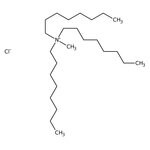Search Thermo Fisher Scientific
Aliquat|r 336 TG, Thermo Scientific Chemicals



Aliquat|r 336 TG, Thermo Scientific Chemicals
Chemical Identifiers
Specifications
Description
This Thermo Scientific Chemicals brand product was originally part of the Alfa Aesar product portfolio. Some documentation and label information may refer to the legacy brand. The original Alfa Aesar product / item code or SKU reference has not changed as a part of the brand transition to Thermo Scientific Chemicals.
Aliquat 336 is widely utilized as a phase transfer catalyst for the catalytic oxidation of cyclohexene to 1,6-hexanedioic acid. It is involved in the total synthesis of Manzamine A. It serves as an anti-static agent for textile fabrics and carpeting. It finds application in waste water treatment to control foaming. It has a major application as a metal extraction reagent for cadmium, zinc, iron and rare earth metals. It is used as an effective catalyst for the preparation of methylphenyl ether from sodium phenolate with for methyl bromide.
Solubility
Miscible with benzene and chloroform.
Notes
Incompatible with strong oxidizing agents, acids and bases.
Figures
Documents & Downloads
Certificates
Frequently asked questions (FAQs)
Citations & References
Safety and Handling
Classification of the substance or mixture
CLP classification - Regulation(EC) No 1272/2008
Label Elements
Signal Word
Danger
Hazard Statements
H301 - Toxic if swallowed
H314 - Causes severe skin burns and eye damage
H360FD - May damage fertility. May damage the unborn child
H373 - May cause damage to organs through prolonged or repeated exposure
H410 - Very toxic to aquatic life with long lasting effects
Precautionary Statements
P280 - Wear protective gloves/protective clothing/eye protection/face protection
P301 + P330 + P331 - IF SWALLOWED: Rinse mouth. Do NOT induce vomiting
P303 + P361 + P353 - IF ON SKIN (or hair): Take off immediately all contaminated clothing. Rinse skin with water or shower
P305 + P351 + P338 - IF IN EYES: Rinse cautiously with water for several minutes. Remove contact lenses, if present and easy to do. Continue rinsing
P310 - Immediately call a POISON CENTER or doctor/physician
Additional EU labelling
Restricted to professional users